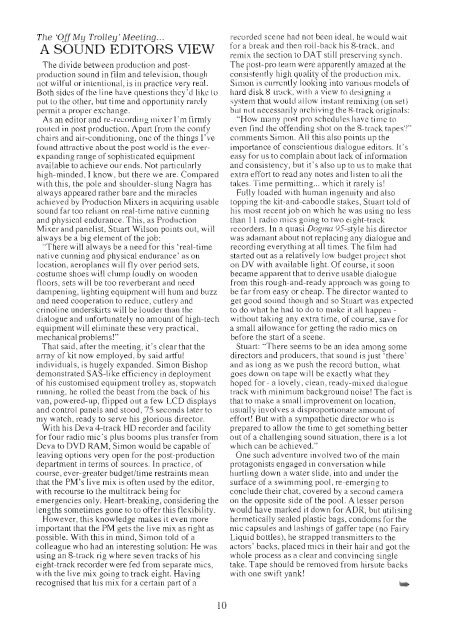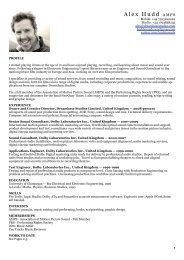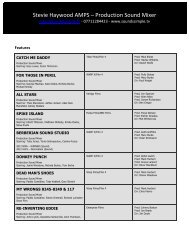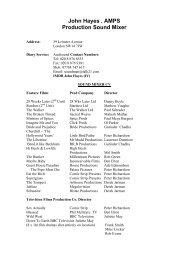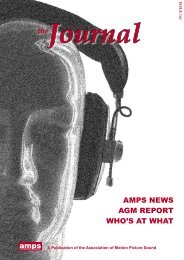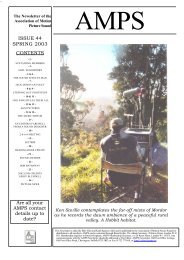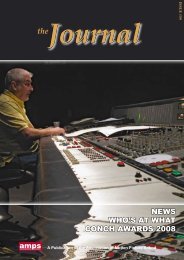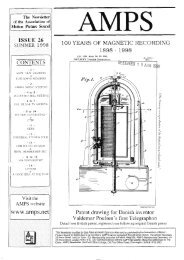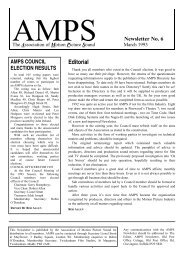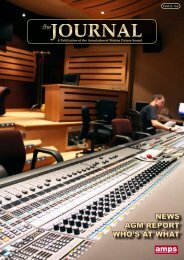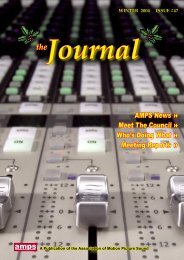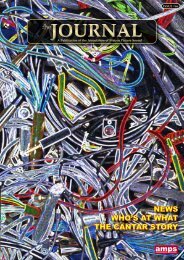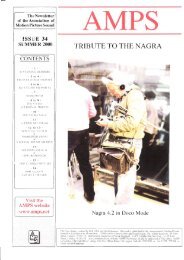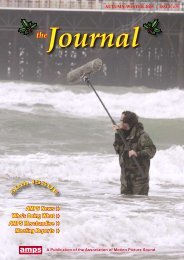Summer 2001 - The Association of Motion Picture Sound
Summer 2001 - The Association of Motion Picture Sound
Summer 2001 - The Association of Motion Picture Sound
Create successful ePaper yourself
Turn your PDF publications into a flip-book with our unique Google optimized e-Paper software.
<strong>The</strong>'Olf Mg Trolley' Meettng...<br />
A SOUND EDITORS VIEW<br />
<strong>The</strong> divide between production artd postproduction<br />
sound in film and television, though<br />
irot wilful or intcntional. is irr practice very real.<br />
Both sidcs <strong>of</strong> the lirre have questions they'd like to<br />
put to the other, Lrut time ancl opportunity rarcly<br />
permit a proper exchauge.<br />
- As an editor ancl re-recortling rnixer I'm firmly<br />
routed in post production. Aparl from the courfy<br />
chairs and air-conditioning, one <strong>of</strong> the things ['ve<br />
found attractive about the post world is the everexpanding<br />
range <strong>of</strong> sophisticated equipment<br />
available to achieve our ends. Not particularly<br />
high-minded,I know, but there we are. Compared<br />
with this, the pole and shoulder-slung Nagra has<br />
always appeared rather bare and the miracles<br />
achieved by Production Mixers in acquiring usable<br />
sound far too reliant on real-time native cunning<br />
and physical endurance. This, as Production<br />
Mixer and panelist, Stuart Wilson points out, will<br />
always be a big element <strong>of</strong> the job:<br />
"<strong>The</strong>re will always be a need for this 'real-time<br />
native cunning and physical endurance' as on<br />
location, aeroplanes will fly over period sets,<br />
costume shoes will clump loudly on wooden<br />
floors, sets will be too reverberant and need<br />
dampening, lighting equipment will hum and buzz<br />
and need cooperation to reduce, cutlery and<br />
crinoline underskirts will be louder than the<br />
dialogue and unfortunately no amount <strong>of</strong> high-tech<br />
equipment will eliminate these very practical,<br />
mechanical problems!"<br />
That said, after the meeting, it's clear that the<br />
array <strong>of</strong> kit now employed, by said artful<br />
individuals, is hugely expanded. Simon Bishop<br />
demonstrated SAS-like efficiency in deployment<br />
<strong>of</strong> his customised equipment trolley as, stopwatch<br />
running, he rolled the beast from the back <strong>of</strong> his<br />
van, powered-up, flipped out a few LCD displays<br />
and control panels and stood, 75 seconds later to<br />
my watch, ready to serve his glorious director.<br />
With his Deva|track HD recorder and facility<br />
for four radio mic's plus booms pltn transfer from<br />
Deva to DVD RAM, Simon would be capable <strong>of</strong><br />
leaving options very open for the post-production<br />
department in terms <strong>of</strong> sources. [n practice, <strong>of</strong><br />
course, ever-greater budgeUtime restraints mean<br />
that the PM's live mix is <strong>of</strong>ten used by the editor,<br />
with recourse to the multitrack being for<br />
emergencies only. Heart-breakin g, considering the<br />
lengths sometimes gone to to <strong>of</strong>fer this flexibility.<br />
However, this knowledge makes it even more<br />
important that the PM geti the live mix as right as<br />
possible. With this in mind, Simon told <strong>of</strong> a<br />
colleague who had an interesting solution: He was<br />
using an 8-track rig where seven tracks <strong>of</strong> his<br />
eight-track recorder were fed from separate mics,<br />
with the live mix going to track eight. Having<br />
recognised that his mix for a certain part <strong>of</strong> a<br />
t0<br />
recorded scene had not been ideal, he would wait<br />
for a break and then roll-back his 8-track, and<br />
remix the section to DAT still pr:eserving synch.<br />
<strong>The</strong> post:pro team were apparently anrazecl at the<br />
consistently high quality <strong>of</strong> the production mix.<br />
Simon is crrrrcntly looking into various models <strong>of</strong><br />
hard disk I track, with a view to designing a<br />
systent that woulel allow irrstartt remixing {on set)<br />
bul. not necessarily archiving the B-track originals:<br />
"How many post pro schedules havc timc to<br />
even find the <strong>of</strong>t'ending shot on the 8-track tapes'/"<br />
comments Simon. Alt this alsn points up the<br />
importance <strong>of</strong> conscientious dialogue editors. It's<br />
easy for us to complain about lack <strong>of</strong> information<br />
and consistency, but it's also up to us to make that<br />
extra effort to read any notes and listen to all the<br />
takes. Time permitting... which it rarely is!<br />
Fully loaded with human ingenuity and also<br />
topping the kit-and-caboodle stakes, Stuart told <strong>of</strong><br />
his most recent job on which he was using no less<br />
than 11 radio mics going to two eight-track<br />
recorders. [n a quasi Dogma 95-style his director<br />
was adamant about not replacing any dialogue and<br />
recording everything at all times. <strong>The</strong> film had<br />
started out as a relatively low budget project shot<br />
on DV with available light. Of course, it soon<br />
became apparent that to derive usable dialogue<br />
from this rough-and-ready approach was going to<br />
be far from easy or cheap. <strong>The</strong> director wanted to<br />
get good sound though and so Stuart was expected<br />
to do what he had to do to make it all happen -<br />
without taking any extra time, <strong>of</strong> course, save for<br />
a small allowance for getting the radio mics on<br />
before the start <strong>of</strong> a scene.<br />
Stuart: "<strong>The</strong>re seems to be an idea among some<br />
directors and producers, that sound isjust'there'<br />
and as long as we push the record button, what<br />
goes down on tape will be exactly what they<br />
hoped for - a lovely, clean, ready-mixed dialogue<br />
track with minimum background noise! <strong>The</strong> fact is<br />
that to make a small improvement on location,<br />
usually involves a disproportionate amount <strong>of</strong><br />
effort! But with a sympathetic director who is<br />
prepared to allow the time to get something better<br />
out <strong>of</strong> a challenging sound situation, there is a lot<br />
which can be achieved."<br />
One such adventure involved two <strong>of</strong> the main<br />
protagonists engaged in conversation while<br />
hurtling down a water slide, into and under the<br />
surface <strong>of</strong> a swimming pool, re-emerging to<br />
conclude their chat, covered by a second camera<br />
on the opposite side <strong>of</strong> the pool. A lesser person<br />
would have marked it down for ADR, but utilising<br />
hermetically sealed plastic bags, condoms for the<br />
mic capsules and lashings <strong>of</strong> gaffer tape (no Fairy<br />
Liquid bottles), he strapped transmitters to the<br />
actors' backs, placed mics in their hair and got the<br />
whole process as a clear and convincing single<br />
take. Tape should be removed from hirsute backs<br />
with one swift yank!<br />
r>


